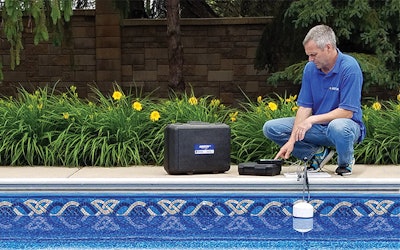
Lance Anderson, president of Anderson Manufacturing, an innovator in the leak detection process for decades, has seen the industry segment evolve and grow over the years. Here, as a follow-up to last month’s AQUA feature on pool inspections for homebuyers, Anderson offers his thoughts on where leak detection leaks fits into the home inspection process and how a new technical innovation may offer a big assist.
AQUA: How does leak detection factor into real estate home inspections?
LANCE ANDERSON: It’s an important and unavoidable aspect of the inspection process. In many cases, the worst-case scenario for someone buying a home with a pool is a leak, and especially a leak that would require a major repair in order to get the pool operating properly. While other focuses of pool inspection are important, they may not have the immediate implications that an undiscovered or hidden leak will have.
AQ: Why don’t leak detections happen every time somebody sells a home that has a pool?
LA: Many pool inspections are done by inspectors that come from the home inspection side of things, and they may not want to address leaks because they have no idea how to go about finding — or even talking about — the problem if one is detected. Some might just do a bucket test to determine whether the pool is leaking or not, but then avoid talking about location. Inspectors have different levels of expertise depending on their background.
AQ: Does this area represent an opportunity for people in the pool and spa industry who do leak detections?
LA: Yes, I believe so. Some are already doing it. Our customers are tremendously varied. We have people who only do leak related work, leak job after leak job. If these companies want to get into the inspection business, it makes sense for them to either educate themselves on other focus areas of the pool (like fencing, equipment, chemistry, alarms, etc.) or advertise their services to inspectors or real estate professionals.
We also have customers that include leak detection as part of their more complete pool and spa services. They do service, repairs, retail and building. This type of company may be better suited to adding a complete pool inspection product. They have the background and foundation to do a complete inspection and provide a report that tells the realtor and home buyer what problems they’re facing.
RELATED: The Leak Mystique
Regardless of the angle from which a pool professional approaches the opportunity, one who has specific leak experience adds value by not just identifying the presence of a problem (detection), but also the specific location of the problem and therefore the type of repair and cost that may be required.
AQ: That’s an important part of the process.
LA: It is, and I personally think there’s a trend in our culture where many people have an interest in passing the buck, so to speak. Some people are reluctant to use their own observations to assess situations that could lead to some form of liability. In that sense, there’s a real opportunity in this area.
There certainly seems to be an increased need for this type of assurance. Anyone who is willing to take responsibility and share their knowledge by producing a report or offering some type of certification provides value that is greatly appreciated.
In many ways the fear of liability is bigger than the real problem, and it can be addressed with proper knowledge and communication. What customers may be looking for more than anything is just to be honestly educated about the pool. Consider the risks of liability and address them with a well-crafted and detailed release form, but don’t let the fear prevent you from sharing your knowledge.
AQ: Has the increased complexity of pool systems increased the frequency of leaks?
LA: I don’t think that increased complexity has led to more leaks. Because while there are more pipes and fittings and components, which logically you’d think would lead to more leaks, at the same time there have been improvements in construction techniques, standards and education.
However, it certainly makes the process of locating a leak more challenging. The more complex a plumbing system is, the more potential places there are for leaks to occur. When you have more systems and components, more plumbing runs and valves, it can be much more challenging to get your head around how the system operates. That’s a big part of leak detection: You’re literally a detective and you have to be creative in how you isolate and examine different parts of the system. The more complex the system, the more challenging it can be, no question about that.
AQ: Do you believe the pool and spa industry should be actively reaching out to realtors and homebuyers to educate them about the availability of inspection services?
LA: Educating the real estate industry is necessary and important. I’m a big fan of free-market forces though, so I’m not sure if it should be an official push by any overriding organization. Sometimes those efforts lead to mandated laws and regulations that can become burdensome and counterproductive. I do think there’s an opportunity for people in our industry to individually reach out to home inspectors and the real estate industry to let them know that they have expertise and the ability to add value to inspection reports. These communications can lead to relationships that create win/win situations.
AQ: How important is it to not only locate the leak but also determine its cause?
LA: This is a part of the inspection and detection process that is often driven by the curiosity of the person doing the inspection, and the customer. We all naturally want to know “why” something happened. It’s also useful because when you understand the cause of a problem you know how to avoid it happening again. It’s rare that identifying the cause is not of importance and interest.
For example, we sell tools designed to help you find leaks in underground plumbing. There are other solutions where a fix can be made without locating the problem; people talk about lining pipes or pumping some kind of material into pipes that have a leak. The selling point is that it saves the cost of going through a deck to repair the leak. The problem with that approach is that you won’t see what caused the problem. It may be there’s a root pressing on the pipe, or a rock where the pipe rubs against it as the pump is turned on and off. That’s very easy to correct so it doesn’t happen again. It’s important to determine the cause of a leak in order to find a lasting fix.
AQ: Are there any technical innovations that could help facilitate the inspection process, whether it’s part of a home inspection or not?
LA: Yes, there are. Keep in mind the traditional way that you determine whether or not there’s a leak is the bucket test. The problem is that this test takes 24 hours, so it requires two trips to the pool, and conditions can change during the time you’re doing the test. We now have a system that takes leak detection from the bucket and into the 21st century.
RELATED: Troubleshooting Pool Leaks
The brand name is the “Leakalyzer.” It’s what we call a rapid water-loss sensor. What it does is measure water loss very precisely, to one ten-thousandth of an inch. As it plots changes in the water level in real time, we’re able to see trends within five, 10 or 15 minutes. We can then extrapolate what that would mean for 24 hours. That has some big advantages. The inspector or service technician can gain information in just one trip instead of two and it provides much more detailed data that is valuable to the customers and can help indicate where the problem is.
AQ: How does that play out in the field?
LA: If, for example, you have a customer who’s complaining because their pool is losing an inch a day or more and sometimes they exaggerate just to get you to make the trip out to their property, you can determine within 20 minutes if they actually have a problem and how big the problem is.
The Leakalyzer is very sensitive. One ten-thousandth of an inch is one one-hundredth the thickness of a piece of paper, about the same size as a red blood cell. That’s incredibly precise. But it cannot distinguish between water loss from a leak and from evaporation. So, the operator has to have an estimate of the loss you can expect from evaporation at the pool. Then you compare the actual loss detected by the system. That tells you if you have a leak.
AQ: How do they compensate for variations in evaporation rates?
LA: What they do is enter an estimated evaporation rate into the Leakalyzer, which results in a straight reference line on the graph [read out] that can be compared to the results of the actual data. If that data is steeper than estimated evaporation, then you know you have a leak.
Although it is usually in a range of ½-to-¼ inch per day, evaporation can vary based on a variety of conditions: water temperature, wind, humidity, etc. We have a calculator on our website that will give you the evaporation index for your area. It tells you what the expected evaporation rate will be based on real time weather data. There are also ways that you can use the sensor to compare water loss when different parts of the system are operating.
It’s another tool that we believe will help streamline the leak detection process. It certainly could play a role in pool inspections for the real estate market and homebuyers and for any other situation where there’s a need find out if and where a pool is losing water.












































